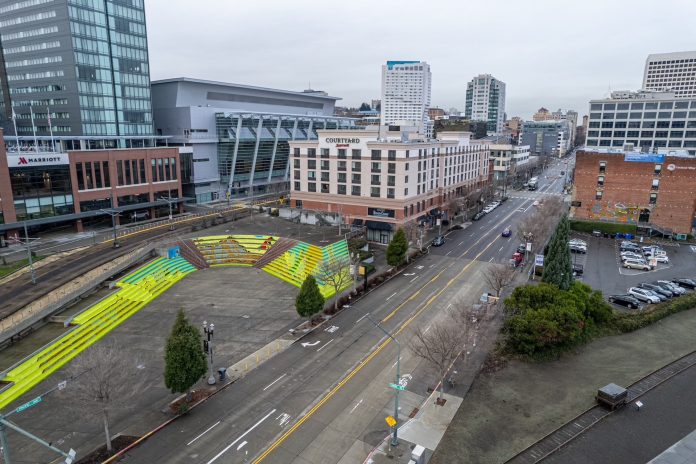Tollefson Plaza in downtown Tacoma confounds me. It’s an attractive space next to a bustling university campus and an art museum. It is adjacent to a pedestrian urban trail, near the city’s convention center, and it is flanked by well-served multi-modal transit stops. But it’s nearly always empty, a deserted public space in an otherwise thriving downtown corridor.
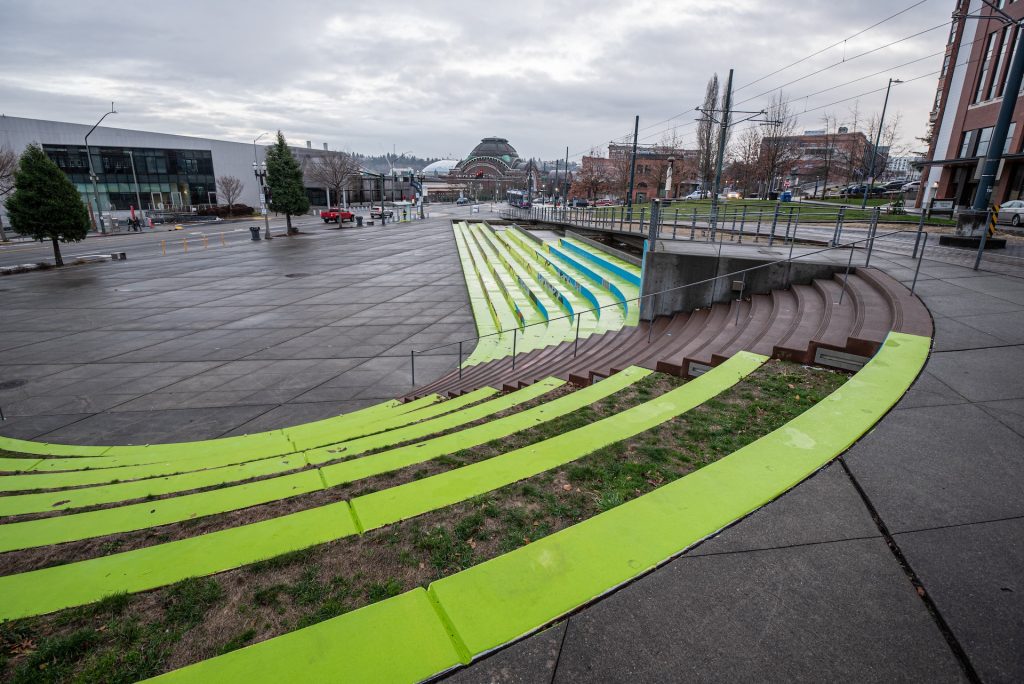
This is not a new phenomenon. In 2006, in an article otherwise celebrating the city’s downtown revival strategy, The Oregonian’s former architecture and urban design writer, Randy Gragg, wrote of the plaza (then known as “Pacific Plaza”): “Tacoma desperately needs some sort of design review: Witness the vacuous new Pacific Plaza urban park…”
That same year, writing on the same subject, The News Tribune’s Dan Voelpel wrote about the plaza:
I’m here. At South 17th and Pacific Avenue. At 2:30 Tuesday afternoon. Under a cloudless spring sky. With 62 degrees flashing on the Heritage Bank sign down the street. By myself. Not counting the pigeons.
Tacoma’s missing ingredient? People. Feet on the street. Action. Buyers. Sightseers. Buskers. Hot dog stands. Sun worshippers. Strollers. Socializers. Anyone.
May 7, 2006
Volpoel’s diagnosis: “We built the spaces without giving people – them and us – enough reasons to use them.” This is as true now as it was in 2006. And, ultimately, a city’s form largely dictates how people live out their public existence within them.
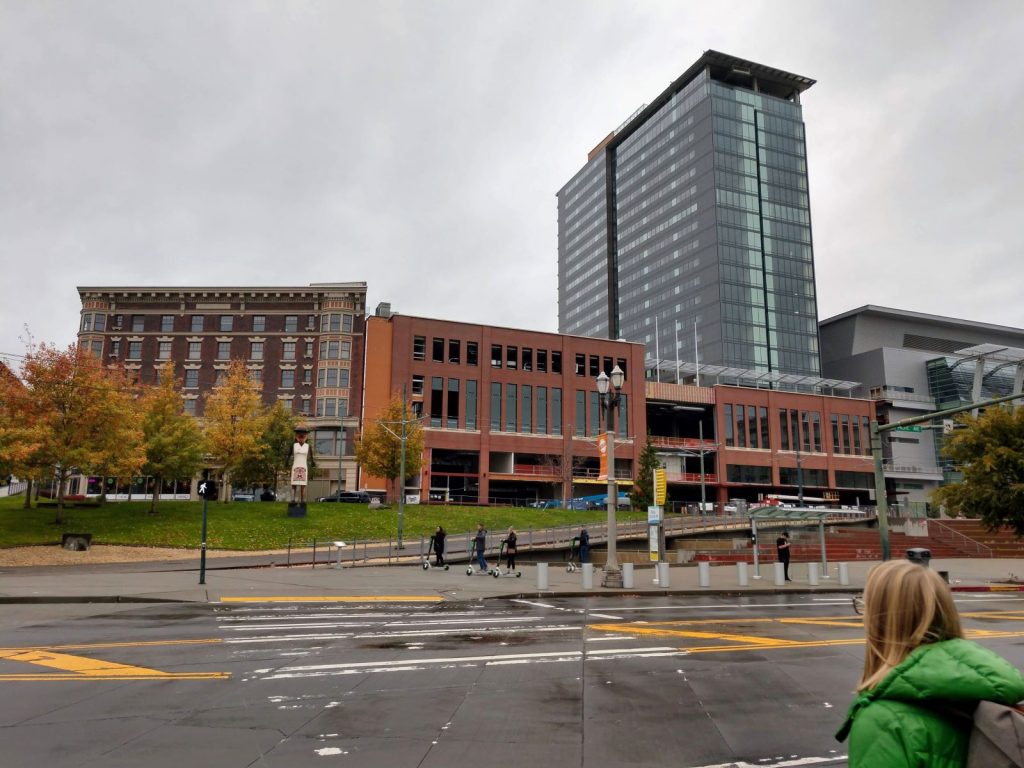
Tacoma’s downtown is mostly a space one moves through, and Tollefson Plaza sits empty in reflection of this.
Community, Closeness, and the Holidays
I’ve been thinking about Tollefson Plaza more recently in reference to the Black Lives Matter (BLM) mural that was recently completed, and to the larger holiday season. The mural is an expression of solidarity with the Black community and is meant to celebrate the achievements and contributions of African Americans throughout history, according to the Tacoma Art Museum. This description falls squarely within the expectations we have for public art — murals are, historically, a form of artistic expression that signify solidarity and a celebration of a particular culture’s contributions. A public space, however, is more than an artistic expression: a public space is a place for people in a city — from across its communities — to come together to forge a better life together. Tollefson Plaza, with its mural, can be and must be more than an expression of solidarity. It can also be a place in which to meet and connect with others towards a better public life.
During the holiday season, our desire for connection and closeness is likewise reflected in our arrangements of space — if only temporarily. Both the miniature Christmas village and the fictional towns featured in holiday movies speak to the intimacy we wish our physical settings supported. The Christmas village is oriented towards a town square or plaza, public spaces alive with public life and activity. The holiday movie brings people into a charming Main Street, or a town square remade with a tall brightly lit Christmas tree. The streets are busy with people doing gift shopping. Characters run into old acquaintances and reconnect.
These are decidedly urbanist visions, and it’s too bad we limit ourselves to these during a few days at the end of each year. If the Christmas village or festive Main Street truthfully incorporated the number of cars that currently populate our existing roads, driveways, planting strips, and downtown parking lots, these would not be very Christmassy at all.
But all this need not be a fantasy. We can have actual proximity, actual closeness, and actual opportunities to connect with neighbors and friends more regularly than we do now — if we build and program spaces to allow for it. If we are open to these festive towns and cozy public spaces during the holidays, we could allow ourselves to build such places throughout the year.
From Bereft to Beloved
Outside of the U.S. public life is organized around regularly occurring spaces for public life. The main square (if in the U.K. or in a city in a country that was colonized by England) or the plaza (if in Spain or a city that was colonized by it) represent an ideology of public life that corresponds to the spaces those societies build for its people. While some cities on the East Coast of the U.S. do feature a prominent square, this genre of public space is not routinely found in U.S. cities, especially in the American West. When they do appear, they are either an exceptional feature of the city — often a tourist attraction and/or a commemorative site — rather than a place for everyday life. When they aren’t exceptional or touristy, they are, as is the case of Tollefson Plaza, devoid of human presence or activity.
In the U.S. cities have tended to organize public life around the commerce and business of Main Street. With its origins in the British High Street, Main Street is where people go to shop, to transact. The Main Street represents another ideology of public life, and therefore prescribes and enforces other types of public activity. In contrast to the square or plaza, which is a destination in and of itself — a site where people go to on purpose and for the purposes of being around others and taking part in non-structured activities, the Main Street is a throughway — it carries traffic through a city, and people only stop to shop. The point is not, so much, to come and stay and visit; rather, the Main Street makes consumers of us all.
As Tacoma, like other cities in our region, continues to grapple with questions about the city it is and wants to become, we have to contend with what philosophy of public life our existing public spaces express and support. Tollefson Plaza is a good place to start asking these questions. Historically and presently, Tollefson Plaza is telling us something about the type of public experience and public life our city’s form prescribes.
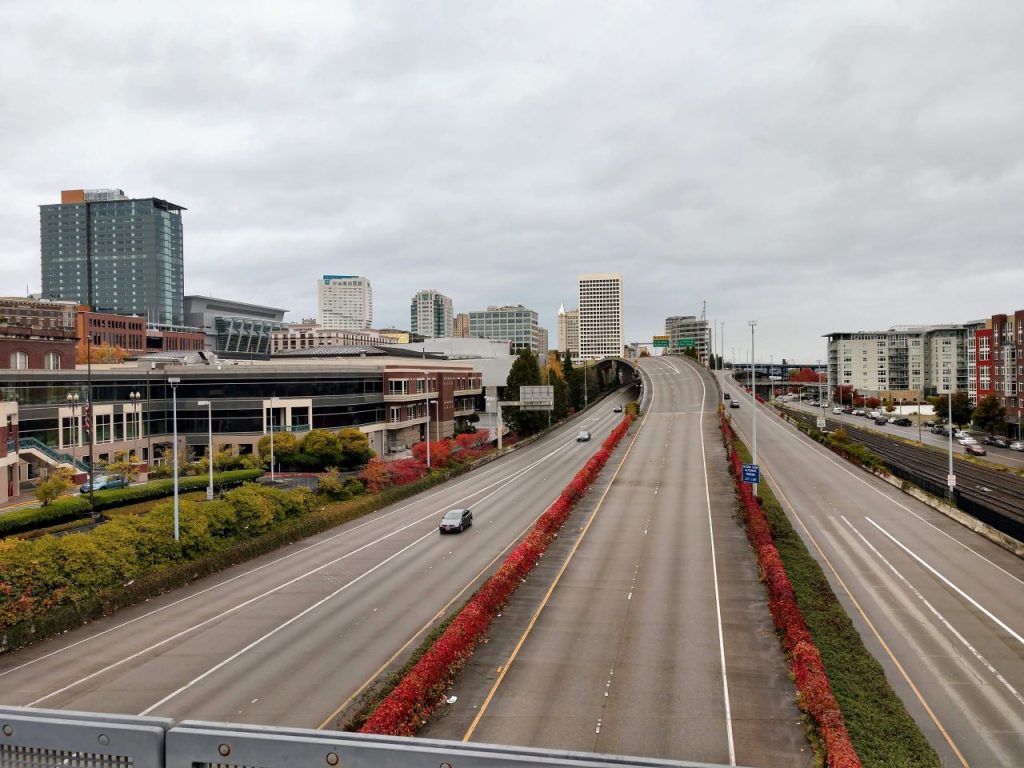
Tacoma does not offer much of a Main Street, either. Pacific Avenue, a de facto frontage road for I-705 meant to carry vehicle traffic in and out of downtown, is wide and therefore encourages high driving speeds that counter the closeness, intimacy, and charm we want from these. Except for the storefronts lining the UWT campus, little else along Pacific Avenue offers the slow, proximate, and cozy feel that people associate with the concept of Main Street. And the other section that, at times, does offer proximity and closeness, the length between 9th and 7th Streets, is too often besieged by people in vehicles prowling for parking or speeding through to get on or off I-705.
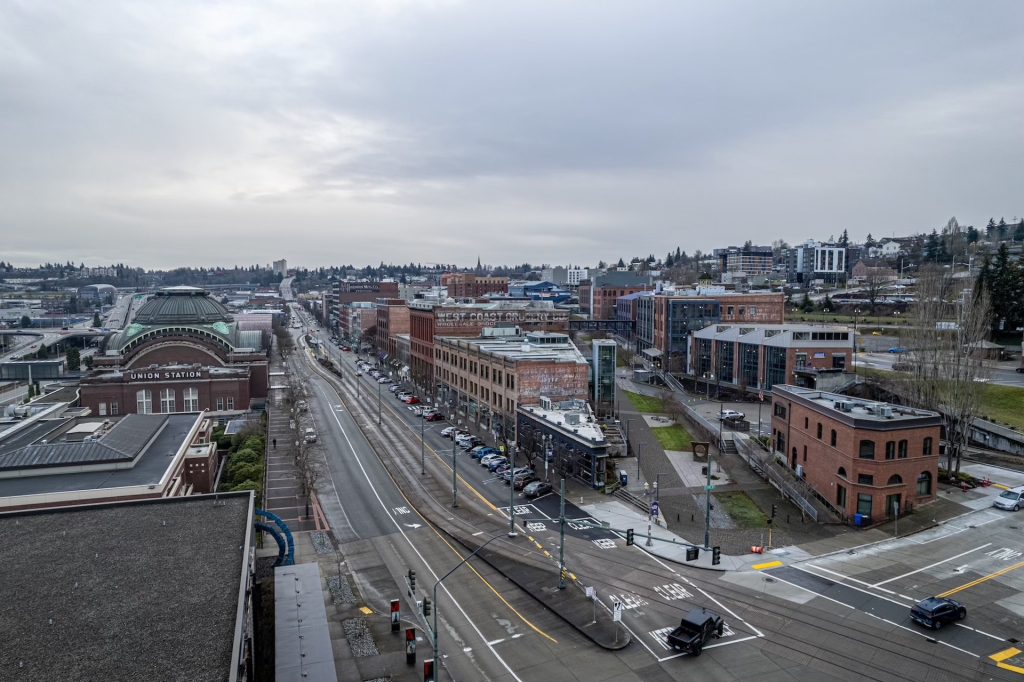
Tacoma’s downtown form and its constitutive spaces don’t currently align with the city we say we want to be. It’s no wonder that Tollefson Plaza is mostly devoid of human presence and activity most times and most days. Nothing about the city’s downtown form recommends it as a place to be. But it could.
Spending time in plazas on the Iberian Peninsula this year, and in Mexico in years before, reveals that some street furniture (patio chairs and tables), better nighttime lighting, and a few trees would create a more inviting space. It wouldn’t hurt to have a coffee cart and lunchtime food carts present either. These additions would serve as an invitation, and some passers-by, students, workers, and nearby residents are sure to accept it. It would be a start. We would also need to re-design and rebuild Pacific Avenue so that the road accommodates more varied public uses.
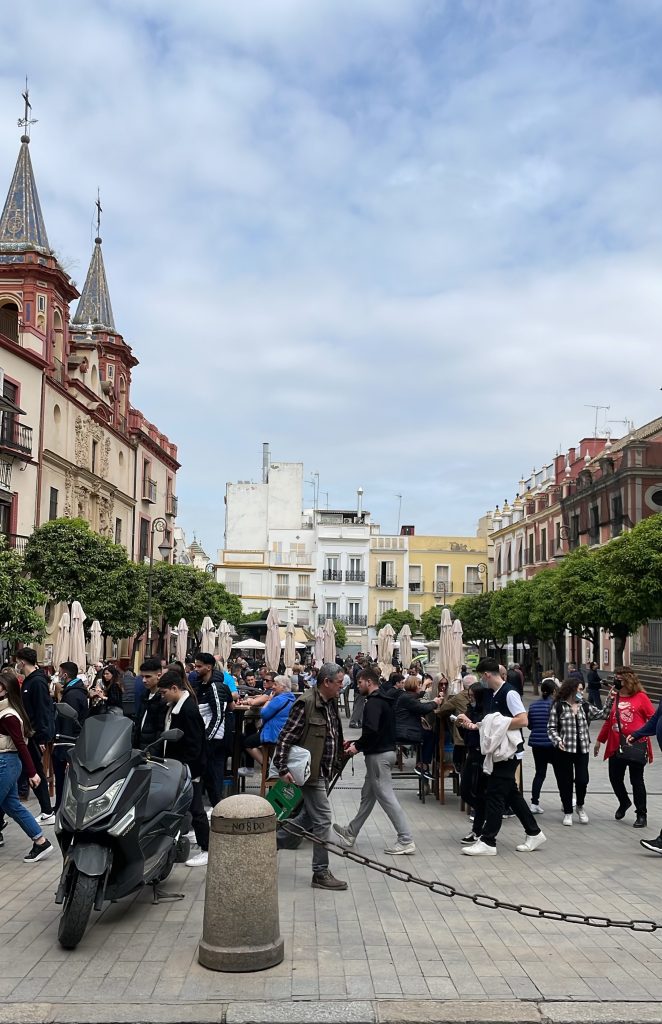
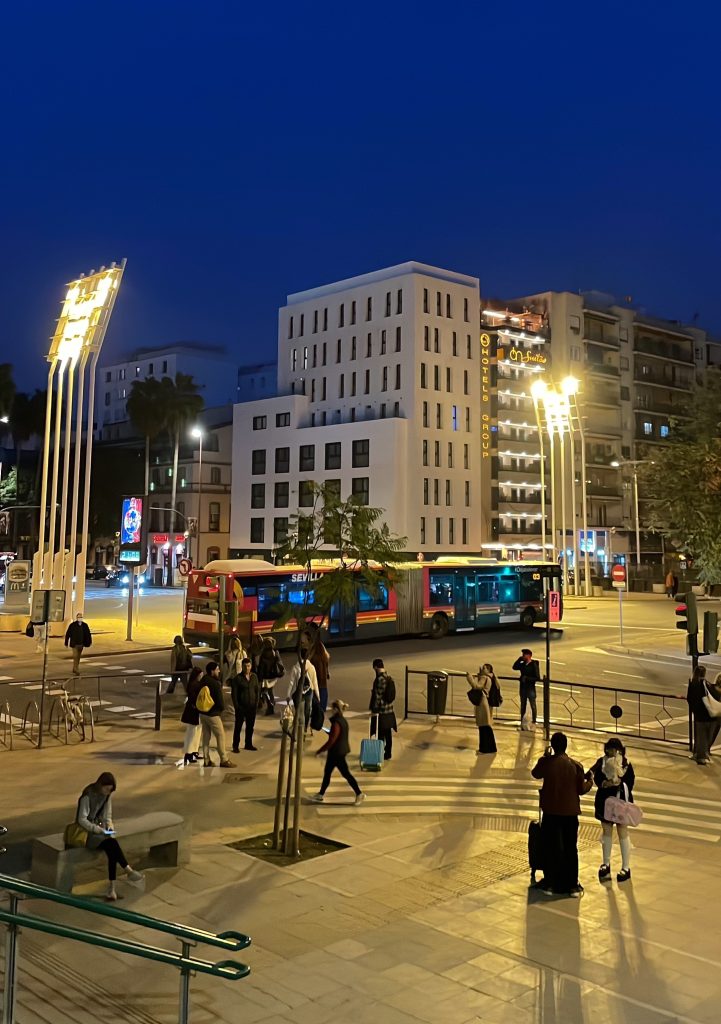
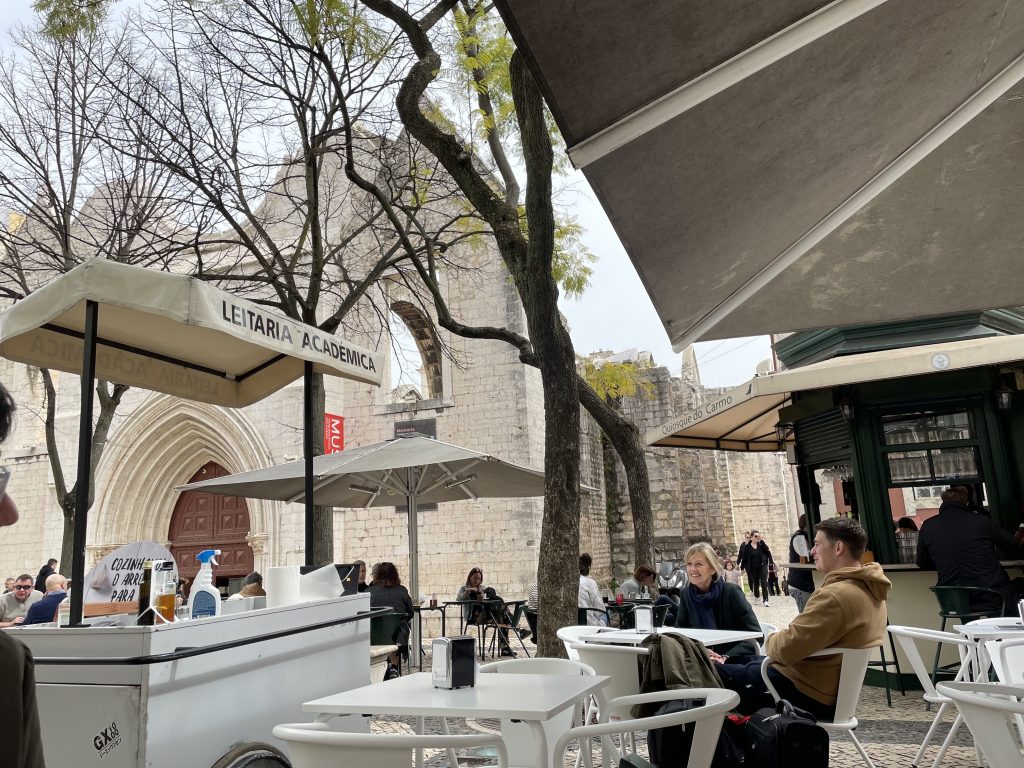
Re-designing and re-making our roads to accommodate more shared uses seems to be underway. Last year, the city added a high-quality protected bike lane along a stretch of East 64th street. The city’s adoption of the Tacoma Streets Initiative and Vision Zero, both of which call for a suite of changes to policy, codes, and physical infrastructure, are a good mechanism through which to transform our city. The traffic-calming modifications that have been added to Fawcett as the road becomes a main bicycle through-way are likewise a good start.
More needs to be done to make our downtown roads accessible and welcoming to pedestrians, which is to say, to people. To do that, we need to think boldly about roads and streets, in particular those in downtown, so that they can better serve pedestrians. Automobile-centric infrastructure is incompatible with a version of the city that puts a premium on public life, connection, and community.
An open and welcoming downtown also needs roads that aren’t open to vehicles at all so that all. We should build a pedestrian corridor between the UWT campus and the convention center along Broadway, and which stretches to City Hall and ends at Opera Alley, as Jeremiah Thomas called for earlier this year in this publication. In its design Broadway already promotes greater access to people than other downtown roads: it offers varied store-fronts, short setbacks, plenty of street trees and abundant public art. Broadway can be an early pilot and a model in the reformations we are after in our city — if we let it.
If we rethink and rebuild or downtown roads to better accommodate people, then Tollefson Plaza can finally become the thriving public space it can be.
More Than a Gesture: What Tollefson Plaza and Downtown Could Be
Having added a community-led BLM mural to Tollefson Plaza reveals a desire to remake this space to better reflect and serve Tacoma communities better. The mural will not be enough. If Tollefson Plaza isn’t also allowed to be an actual gathering place — a place for bodies to meet, connect, and sometimes rally and protest — then the mural will be relegated to a symbolic gesture on the part of the Tacoma Art Museum and the City’s Human Rights Commission. If the plaza isn’t allowed to become an actual place for public life, then we risk it becoming an extension of the museum’s collection — a thing to view and revere, but not necessarily to use.
A mural that expresses institutional solidarity with Black communities must be matched with reforms to public space that make the city less deadly and more just for Black, Indigenous, and people of color (BIPOC). Our city and region continue to grapple with high levels of injury and death on roadways, the legacy of urban planning and development that has privileged cars above all else, especially the safety and life of BIPOC and those living in poverty. Also, roads are where many Black Americans and other people of color are experiencing police violence. Further, BIPOC are over-represented among the frontline communities experiencing the already-here severe weather impacts of a changing climate, a reality brought on by our reliance on polluting mobility options.
Prioritizing vehicles in our legacy design and planning practice has also meant that those who are facing the worst of climate change are also the ones who are forced into expensive mobility choices and into commuting patterns that cost them more now and which will cost all of us in the near– and long-term.
Now that we have made the plaza the host of a BLM mural, let the plaza also be a space for people to connect and in which to build community. Let the plaza be the start of a revision to our city’s physical form — from one that exacts disconnection and creates further peril for city residents — to one that supports the closeness and connection we seek out during the holiday season.
Rethinking and remaking a city’s form and functions is, ultimately, an exercise in rethinking and remaking our relationships to one another. In an era that is characterized by isolation, disconnection, and the trauma that emerges from continued racial violence, political divisions, and rampant inequality, we need to rethink our cities so that, through their form, more of us are brought together. May this new year bring a renewed will and effort towards these reconsiderations and may we all have the will to see these transformations through.

Rubén Casas
Rubén joined The Urbanist's board in 2022. He is a scholar and teacher of rhetoric and writing at the University of Washington Tacoma. He is also the faculty lead of the Urban Environmental Justice Initiative at Urban@UW. In his work and advocacy, Rubén examines how cities and the institutions that comprise them imagine, plan, and build in ways that promote and/or discourage community and a sense of place.


